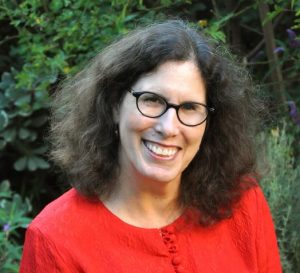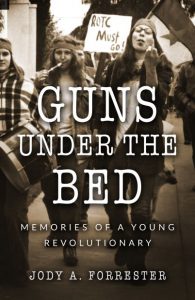Guns Under The Bed: Memories of a Young Revolutionary
 The debut of my memoir, Guns Under the Bed: Memories of a Young Revolutionary, (Odyssey Books/AU), has been moved back from June 1 to September 1, 2020, because the bookstores where launch events were scheduled have had to close due to the pandemic. Disappointing, but given all that’s happening, it’s a small thing. Still, I’d like to let you all know about it, hoping that when the time comes, you’ll be interested enough to seek it out.
The debut of my memoir, Guns Under the Bed: Memories of a Young Revolutionary, (Odyssey Books/AU), has been moved back from June 1 to September 1, 2020, because the bookstores where launch events were scheduled have had to close due to the pandemic. Disappointing, but given all that’s happening, it’s a small thing. Still, I’d like to let you all know about it, hoping that when the time comes, you’ll be interested enough to seek it out.
The seed for my book first sprouted when I was in the second semester at the MFA writing program at Bennington College. Askold Melnyczyk, my teacher, met with each of his students on the first day to ask what our story was. When it was my turn, he dug deep, and eventually I revealed a secret that I had kept for more than forty years. Instead of being horrified, as I thought anyone would be, he said ‘that’s it – that’s your story,’ giving me the courage needed to unwrap what had long been kept in the dark. For in what conversation does one say, “When I was a freshman in college, I was a revolutionary who slept with guns under my bed.”
I began writing the memoir more than eight years ago, but unwilling then to call it nonfiction, the initial format was a series of short stories. Eventually I gave that up because, already knowing the ending, it was near impossible to write it as fiction. That led to a series of personal essays until another teacher, Samantha Dunn, made me see that I was writing a book. Once realized, I spent another couple of years formatting and structuring it into chapters. Quite an ordeal, but well worth it!
This book revolves around the three years when I was in my late teens transitioning from sixties love child to pacifist anti-Vietnam War activist to an ardent communist revolutionary. Believing that the organization, Revolutionary Union, offered the ideology necessary to form a world without class and race divisions, I joined with enthusiastic idealism. In anticipation of a working class led uprising, I slept with two rifles underneath my bed.
One of millions protesting the war, what set me apart from my peers was my decision to join a group espousing Mao Tse Tung’s ideology of class war. But why? How did I come to embrace violence as the solution to the inequities inherent in a capitalist empire? To find the answer to that question, I looked far into my past to better understand who I was, and in the process came to realize that what I’d always thought of as political was also deeply personal.
Following is an excerpt from chapter 12:
On October 29, 1970, more than 10,000 demonstrators, including laid-off aerospace engineers and scientists, showed up outside the San Jose Civic Auditorium where Richard Nixon was speaking at a GOP fundraiser. Inside I imagined all were cheering, while those of us outside waited for his exit to show our contempt and anger. When he finished, Nixon left the hall to the rear where his convoy, already surrounded by protesters chanting anti-war slogans, was parked. All was noise, nothing yet thrown, when the President, unanticipated by his security, climbed onto the hood of his limousine to flash two fingers in a peace sign to the crowd.
 In his book, The Memoirs of Richard Nixon, he wrote, “I couldn’t resist showing them how little respect I had to their juvenile and mindless ranting.” At that point he was only one hundred fifty feet from the flimsy barriers erected earlier by the police. Chunks of concrete from construction debris in the back of the parking lot started to fly. The secret service pulled him down, stuffing him into the back seat. The convoy started to move but stalled a moment later when the front car was hit with a rock producing a chain reaction crash of six vehicles. Numerous reports estimated that more than a thousand people threw eggs, rocks, and bottles.
In his book, The Memoirs of Richard Nixon, he wrote, “I couldn’t resist showing them how little respect I had to their juvenile and mindless ranting.” At that point he was only one hundred fifty feet from the flimsy barriers erected earlier by the police. Chunks of concrete from construction debris in the back of the parking lot started to fly. The secret service pulled him down, stuffing him into the back seat. The convoy started to move but stalled a moment later when the front car was hit with a rock producing a chain reaction crash of six vehicles. Numerous reports estimated that more than a thousand people threw eggs, rocks, and bottles.
I was standing just an arm’s length away from Nixon’s limousine when it stopped short. His scowling face and my wide-opened mouth reflected in the glass.
Somebody handed me a fist-sized piece of concrete. Intimidated by fear and timidity, I first backed away but then adrenaline kicked in ignited by scalding rage. My first strikes against his window were light but then a decision I was conscious of making pushed aside self-preservation, providing the impetus to begin a full-scale offensive, pummeling and pounding the rock against the rear window. Cracks in the glass cobwebbed from each strike. I wasn’t the only one. Demonstrators swarmed the car, some beating on windows, others on the roof. When the limousine lurched forward, I saw more than felt how bloody my hand was.
The next day President Nixon gave a speech in which he claimed: “The stoning at San Jose is an example of the viciousness of the lawless elements in our society.” It was he who termed the event a ‘stoning,’ posturing himself as a sainted martyr. Given that the “lawless” elements included thousands of workers laid off as a result of his economic policies, he had a hell of a nerve.
Less than four years later, President Nixon would resign before he could be impeached for crimes related to the Republican-sponsored burglaries of the Democratic National Committee headquarters in D.C.’s Watergate office complex. Documents were stolen and wiretap devices installed. Nixon did everything he could to deny involvement but the intended cover-up led to indictments. I was disappointed he wasn’t charged with war crimes, since that was truly what he was guilty of.
Years later, in my initial foray into the Internet for news from that time, I found a picture in the San Jose Mercury News accompanying an article headlined the “Stoning of Nixon.” Is that really me, the tall girl, her long dark hair held back by a kerchief, pounding a piece of concrete against the rear window of the President’s limousine only inches away from Nixon’s face? So angry, so aggressive, so bold, forever memorialized.
Thank you for reading,
Jody A. Forrester
—
Jody A. Forrester was born and raised in Los Angeles, California. Following graduation from Fairfax High School (1969), she moved first to San Jose and then to Vancouver, Canada, before returning to Los Angeles to attend Cleveland Chiropractic College in 1980. She married, opened her office in Santa Monica, and gave birth to two daughters soon after.
After twenty-four years of practice, Jody was forced into retirement from a wrist injury requiring surgery. At that time, she returned to school to pursue writing, a long-time dream that for lack of confidence had been put on the back burner. Graduating with a BA from Antioch College, Los Angeles, and a MFA from Bennington College, her stories and essays have been published and awarded in many publications. She lives now in Venice, California, with her husband, John Schneider and their Australian Shepherd, Charley.
https://www.facebook.com/profile.php?id=100001532824693
https://www.instagram.com/jodyaforrester/
Twitter; https://twitter.com/jaforrester2
Category: Contemporary Women Writers, How To and Tips































Barbara Bos and Books by Women –
Thanks so much for featuring my launch today for Guns Under the Bed: Memories of a Young Revolutionary. Your support is much appreciated!
All best wishes,
Jody